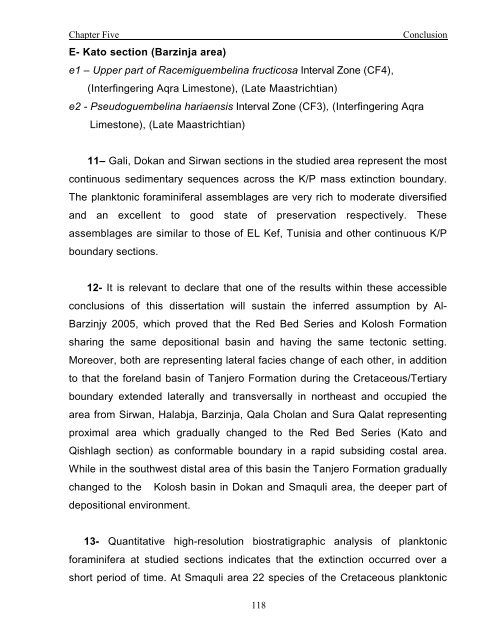biostratigraphy and paleoecology of cretaceous/tertiary boundary in ...
biostratigraphy and paleoecology of cretaceous/tertiary boundary in ...
biostratigraphy and paleoecology of cretaceous/tertiary boundary in ...
Create successful ePaper yourself
Turn your PDF publications into a flip-book with our unique Google optimized e-Paper software.
Chapter Five<br />
Conclusion<br />
E- Kato section (Barz<strong>in</strong>ja area)<br />
e1 – Upper part <strong>of</strong> Racemiguembel<strong>in</strong>a fructicosa Interval Zone (CF4),<br />
(Interf<strong>in</strong>ger<strong>in</strong>g Aqra Limestone), (Late Maastrichtian)<br />
e2 - Pseudoguembel<strong>in</strong>a hariaensis Interval Zone (CF3), (Interf<strong>in</strong>ger<strong>in</strong>g Aqra<br />
Limestone), (Late Maastrichtian)<br />
11– Gali, Dokan <strong>and</strong> Sirwan sections <strong>in</strong> the studied area represent the most<br />
cont<strong>in</strong>uous sedimentary sequences across the K/P mass ext<strong>in</strong>ction <strong>boundary</strong>.<br />
The planktonic foram<strong>in</strong>iferal assemblages are very rich to moderate diversified<br />
<strong>and</strong> an excellent to good state <strong>of</strong> preservation respectively. These<br />
assemblages are similar to those <strong>of</strong> EL Kef, Tunisia <strong>and</strong> other cont<strong>in</strong>uous K/P<br />
<strong>boundary</strong> sections.<br />
12- It is relevant to declare that one <strong>of</strong> the results with<strong>in</strong> these accessible<br />
conclusions <strong>of</strong> this dissertation will susta<strong>in</strong> the <strong>in</strong>ferred assumption by Al-<br />
Barz<strong>in</strong>jy 2005, which proved that the Red Bed Series <strong>and</strong> Kolosh Formation<br />
shar<strong>in</strong>g the same depositional bas<strong>in</strong> <strong>and</strong> hav<strong>in</strong>g the same tectonic sett<strong>in</strong>g.<br />
Moreover, both are represent<strong>in</strong>g lateral facies change <strong>of</strong> each other, <strong>in</strong> addition<br />
to that the forel<strong>and</strong> bas<strong>in</strong> <strong>of</strong> Tanjero Formation dur<strong>in</strong>g the Cretaceous/Tertiary<br />
<strong>boundary</strong> extended laterally <strong>and</strong> transversally <strong>in</strong> northeast <strong>and</strong> occupied the<br />
area from Sirwan, Halabja, Barz<strong>in</strong>ja, Qala Cholan <strong>and</strong> Sura Qalat represent<strong>in</strong>g<br />
proximal area which gradually changed to the Red Bed Series (Kato <strong>and</strong><br />
Qishlagh section) as conformable <strong>boundary</strong> <strong>in</strong> a rapid subsid<strong>in</strong>g costal area.<br />
While <strong>in</strong> the southwest distal area <strong>of</strong> this bas<strong>in</strong> the Tanjero Formation gradually<br />
changed to the Kolosh bas<strong>in</strong> <strong>in</strong> Dokan <strong>and</strong> Smaquli area, the deeper part <strong>of</strong><br />
depositional environment.<br />
13- Quantitative high-resolution biostratigraphic analysis <strong>of</strong> planktonic<br />
foram<strong>in</strong>ifera at studied sections <strong>in</strong>dicates that the ext<strong>in</strong>ction occurred over a<br />
short period <strong>of</strong> time. At Smaquli area 22 species <strong>of</strong> the Cretaceous planktonic<br />
118

















